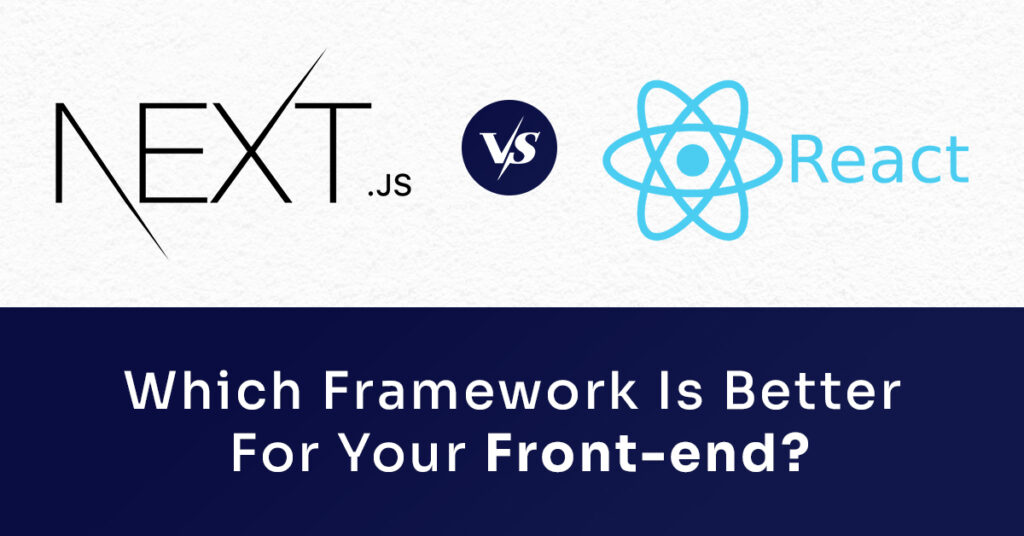Next JS vs React: Which Framework to Choose for Front-end

Summary: Are you a front end developer? Then you must be familiar with Next Js and React tools. Is NextJs better than React? Which is better, ReactJs or Next Js? These are some questions that run through developers’ minds. We have answered your question in this article, explore;
Completing a project is hard enough, and the added confusion regarding these tools further compounds the problem. Even company owners think – should I hire React Js developers or Next Js developers? React is a Javascript-based UI development library while Next Js is a React based framework that is used to build server-side rendering and static web applications.
React UI library is extensive but it requires more configuration and tooling. Hence, React can be a little complicated for beginners and developers that want a simplistic approach. On the other hand, Next Js is a frontend Javascript framework based on React UI library. The primary objective is to minimize Javascript’s limitations and help developers create apps in a zero-config environment, providing them the tools to accomplish complex projects.
Next Js vs React – this is what our blog will discuss. Without further ado, let us dive straight into it.
What is React?
When it comes to creating a high-performing and engaging user interface, React JS is the first name that comes in developers’ minds. Facebook introduced React 9 years ago in 2013 and since then it is one of the most favored JavaScript libraries —front end development platforms. Front-end developers use React to create interactive applications for smartphones, the web, and other platforms. However, developers use ReactJS for front-end development, primarily as the platform offers handy features, tools, and functionalities to create an interactive customer-facing interface.
Whenever we click on anything on the web page the whole page will reload. However, react JS web app development allows you to create single, isolated, and reusable components. React developers do not have to create multiple codes for the same features. Changes implemented in a particular segment will not affect the entire app or website.
Together with React Native and Redux, React is used to build interactive UI interfaces.
What is Next Js?
Vercel created Next.js based on the top of Node.js which helps developers create React based website that requires little to no configuration. Developers love using Next Js because of its adaptability, responsiveness, and faster time to market. The web development framework is widely used for creating static websites while providing React like functionalities including server-side rendering, and generating top-note static websites.
Moreover, NextJS is an open-source tool elicited from Node.js and Babel while integrating successfully with React to develop single page apps. Creating hybrid pages along with static and server side rendered pages becomes a cakewalk with Next Js. Faster page loading and SEO friendliness coupled with robust data security are other reasons why developers love Next Js.
Next JS vs React
1. Speed and coding effectiveness
Creating pages with React involves the creation of components that have to be added to the router. With Next Js, all the developer has to do is create pages and add them to the folder, followed by the addition of the component header link. With minimal coding and configuration, developers can create formidable apps and that too in less time.
2. Feature comparison
Both React.js and Next.js come with outstanding features enabling develoeprs to create highly effective and scalable web applications with excellent UI. We have listed some of the top featuares of both React and Next Js so you can udnerstand what best fit to your next web application project.
Salient features of React
- JSX (JavaScript Syntax Extension)
- Virtual DOM
- One-way data binding
- Performance
- Extensions
- Conditional statements
- Components
- Simplicity
- Routing
- Management patterns
Salient features of Next Js
- Built-in CSS
- Image Components and Image Optimization
- Static File Serving.
- Typescript
- Supported Browsers and Features
- ESLint
- Automatic Code Splitting. …
- Fast Refresh
- Meta tags
- Routing
- Lazy loading
- Layouts
- Data fetching
3. Documentation
While comparing React and Next Js, documentation is a critical factor. There is no doubt that homepages created using the frameworks are more eye-catching but beginners will need tutorials, articles and courses for better understanding and implementation.
Both NextJs and React have a practical documentation guide that walks you through tasks like directing and component creation. For both Next Js and React, it is advisable to access their official documentation for first hand knowledge and lucid explanation.
4. Performance
This point is the key differentiator between React and Next js. Next Js scores over React in the performance department because of valuable features like server-side rendering, image optimization and static destinations. Thanks to these features, websites developed with Next Js perform better than React based ones.
React supports client-side rendering which is incompatible with SEO plus its slower loading time impacts website performance. Furthermore, choosing Next Js over React allows you to enjoy features like code-splitting and automatic server-side rendering, resulting in optimal website performance.
5. Configuration
Configuration is another integral point of comparison between React and Next Js. React can be tough to configure. Set ups will not change until you disconnect from the Create React application. You will have to use the Create React app during set up or it will be configured in CRA read scripts.
Compared to React, Next Js has little configuration because of its server-side rendering. Additionally, with Next Js, you can configure using babelrc, jest.config, eslintrc etc.
6. Server-side rendering
NextJs supports server-side rendering while React does not. Every time a request is raised, Next Js fetches the data.
React supports client-side rendering but you can configure server-side rendering into it. However, the configuration process is complex and time-consuming.
7. Maintenance
Both React and Next Js are maintained properly. React has a large community with industry’s top developers contributing and maintaining the library. Regular updates and improved versions are released regularly. React developers and Next Js developers have to be proactive and install updates/new versions for optimal functioning and maintenance.
8. Typescript
React is the foundation of the CRA application with TypeScript as a result of npx create-react-app my-app –template typescript’. On the other hand, Next Js supports typescripts and configurations through the presence of tsconfig.json. In short, both has Typescrpt feature that enable developers to provide highly effective and productive development tools for JavaScript IDEs and practices. Typescript plays significant role in providing productive application with clean coding.
9. Developer hiring
The React tool was introduced around 2012 while Next Js was introduced in 2016. Hence, finding React developers is relatively easier as compared to Next Js developers. Ensure that React developers know the ins and outs of Javascript. NextJs developers must have a fair understanding of React. Keep that in mind while hiring Next Js developers.
You may find more developers for React than Next Js due to the factors mentioned above. Having said that, things change with time. Many predict a healthy demand for React, Next Js, and React Js developers in the future.
10. Community support
Both Next Js and React are open-source and you need community support if you encounter errors or other technical issues. React’s community has plenty of experienced developers plus you get guidance through blogs, tutorials, videos and other learning material. You can even find an exclusive developer community on Stackflow.
If you need assistance with Next Js, you can find it on Github. Although Github’s Next Js developer community is fairly new, you will receive assistance. Overall, both React and Next Js provide robust community support.
11. Development cost
Since React and Next Js are open-source platforms, the development cost is low. Finding React developers would be comparatively easier than finding Next Js developers. The simple reason is that React is a much older platform. Nevertheless, you can find developers for both Next Js and React if you use the right resources and channels.
Besides, both are open source, so you do not need to invest in even a single penny to buy the platforms, apart from the development cost per hour you pay to developers or Development companies.
12. Learning curve
Developers need to put in substantial time and effort to learn about both platforms. These efforts will help them write codes that are easier to write, read and maintain. Moreover, self-learning and research also help developers utilize the tools in the library or frameworks.
Between React and Next Js, developers find it easier to learn React plus community support eases the learning process. In contrast, Next Js is easy but developers require a fair bit of knowledge to use it. Beginners in frontend development with a fair knowledge of Next Js can code effectively.
In a nutshell
Both React and Next Js have their pros and cons. So, before choosing a particular framework or a library, it is crucial to understand the client’s requirements and the project’s demands. React provides more opportunities for customization along with strong community support.
Next Js has a wider set of tools and resources that can take front end development to a new level. Now that you know about Next Js and React, you can take up that prized project and deliver exceptional results.
Also read: Top Java Web Development Technologies You Must Know In 2022
Do you need help with finding React or ReactJs developers? Look no further, contact us here. Whether it’s hiring React js developers,NextJs developers or developing next-gen software, we are here to help. All you need to do is state your budget and requirements. Let’s connect now.

Mahesh Kumar is a dynamic marketing consultant and tech enthusiast with a passion for driving business growth through his innovative strategies and cutting-edge technology. With 6 years of experience in the industry, he has helped numerous businesses leverage the power of digital marketing to reach their target audience, build brand awareness, and increase sales.








